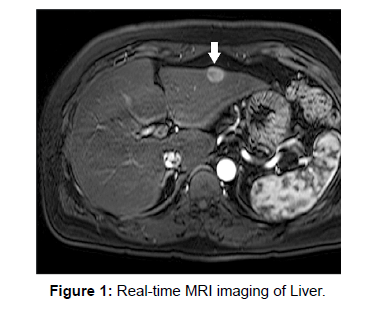Quantitative Liver Capability Analysis Using MR Imaging
Received: 03-Nov-2022 / Manuscript No. roa-22-82177 / Editor assigned: 05-Nov-2022 / PreQC No. roa-22-82177 (PQ) / Reviewed: 19-Nov-2022 / QC No. roa-22-82177 / Revised: 22-Nov-2022 / Manuscript No. roa-22-82177 (R) / Published Date: 29-Nov-2022 DOI: 10.4172/2167-7964.1000410
Image Article
Quantitative evaluation of liver capability is important not only for observing that function but also for evaluating the liver reserve prior to surgery [1].
Since Indocyanine Green is only removed from distribution by the liver, the Plasma Disappearance Rate has been regarded as an important tool for quantitatively evaluating liver function [2]. However, to our knowledge, there is no established method for the quantitative anatomically based assessment of segmental liver capability (Figure 1).
It has been established that a quantitative liver function test, such as the ICG clearance test, and the Future Remnant Liver Volume are significant predictors of postoperative liver failure and mortality [1,3].However, because the heterogeneity of the liver function could not be taken into account with volumetry, an accurate assessment of the segmental liver reserve may not be possible [4].
Gadoxetate disodium is a paramagnetic hepatobiliary contrast specialist that has the ability to combine the characteristics of a hepatocellular contrast agent and extracellular agents. The same transportation frameworks (for instance the Natural Anion Shipping Polypeptides, OATPs) are seen as obligated for take-up of gadoxetate disodium and ICG in hepatocytes. As a result, gadoxetate disodiumimproved MR imaging may serve as the foundation for a useful method for quantitatively assessing postoperative liver disappointment, such as ICG clearance, while also allowing for anatomic delineation of hepatic function.
References
- Seyama Y, Kokudo N (2009) Assessment of liver function for safe hepatic resection. Hepatol Res 39: 107-116.
- Sakka SG (2007) Assessing liver function. Curr Opin Crit Care 13: 207-214.
- Suda K, Ohtsuka M, Ambiru S, Kimura F, Shimizu H, et al. (2009) Risk factors of liver dysfunction after extended hepatic resection in biliary tract malignancies. Am J Surg 197: 752-758.
- Yamada A (2012) Quantitative Evaluation of Liver Function within MR Imaging. OMICS J Radiol 1: e109.
Indexed at, Google Scholar, Crossref
Indexed at, Google Scholar, Crossref
Indexed at, Google Scholar, Crossref
Citation: Akirha T (2022) Quantitative Liver Capability Analysis Using MR Imaging. OMICS J Radiol 11: 410. DOI: 10.4172/2167-7964.1000410
Copyright: © 2022 Akirha T. This is an open-access article distributed under the terms of the Creative Commons Attribution License, which permits unrestricted use, distribution, and reproduction in any medium, provided the original author and source are credited.
Share This Article
Open Access Journals
Article Tools
Article Usage
- Total views: 1521
- [From(publication date): 0-2022 - Mar 29, 2025]
- Breakdown by view type
- HTML page views: 1187
- PDF downloads: 334

